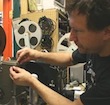|
Author
|
Topic: Suggest: don't lub your films by an oily matter
|
|
|
Panayotis A. Carayannis
Jedi Master Film Handler
Posts: 969
From: Athens,Greece
Registered: Jul 2008
|
 posted June 07, 2009 03:30 PM
posted June 07, 2009 03:30 PM



Both paraffin and vaseline are byproducts of petrol.The first, usually sold in pharmacies as "paraffin oil" is a transparent rather thick liquid while the second is a white thick cream. Both are good for the skin (the former is also a good laxative !) , but not for the film. They are "oily" and can leave stains everywhere, plus the "sticky" problems you mentioned. The "method" you describe was perhaps used as a cheap alternative by cinema projectionists,since 35mm prints were destined for an x number of showings and afterwards were supposed to be destroyed and ,in addition,35mm projectors,being bigger and harder,weren't bothered by this problem. But,for the smaller formats it is a no-no.
| IP: Logged
|
|
|
|
|
|
|
|
|
|
Ugo Grassi
Jedi Master Film Handler
Posts: 506
From: Avellino (Italy)
Registered: Dec 2003
|
 posted June 09, 2009 05:19 AM
posted June 09, 2009 05:19 AM



quote from Kodak's site:
Lubrication
All motion-picture films destined for projection are required some level of lubrication. The lubricant incorporated in some 8 mm or 16 mm films may be sufficient, even after processing. Since all films may not be lubricated, it should be done to assure a smoother projection. Most laboratories do apply a lubricant when necessary. Caution: Solvent film cleaners or lubricants require adequate ventilation and avoidance of prolonged contact with skin. If these precautions cannot be met, employ a professional firm to clean and lubricate the films. Also, local municipal codes must be strictly adhered to in using and disposing of any solvents.
Theatrical 35 mm release prints require considerably higher levels of lubrication to provide trouble-free performance during projection nuns. Since the required amount of lubricant is excessive for overall application, it is applied to the perforated film edges only on the emulsion side. During windup, some of the lubricant transfers to the film edges on the support side. The edge-wax solution consists of 50 grams of paraffin wax dissolved into 1 1itre of inhibited 1.1.1 Trichloroethane and is usually applied by a special edge-waxing machine. For more information, refer to the SMPTE Recommended Practice, RP151-1989, Lubricatlon, Print.
To lub the films by an oily matter is raccomanded by Kodak and SMPTE. Anyway this is right for the 35 mm only. The "forces in play" are different and different is the mechanism to move the film. The Geneva (or Maltese) cross is more resistant then our claw for a lot of reasons. Every tooth is able to support an higher pressure where it engages the hole, as regards what the claw is able to do.
A lubricant right for the 35mm isn't sure right for a smaller format.
Anyway I don't know what is the liquid on the film. I know only it's an oily matter...
[ June 09, 2009, 07:13 AM: Message edited by: Ugo Grassi ]
--------------------
Bye
Ugo
| IP: Logged
|
|
|
|
|
|
|
|
|
|
|
|
|
|
Osi Osgood
Film God

Posts: 10204
From: Mountian Home, ID.
Registered: Jul 2005
|
 posted June 10, 2009 11:07 PM
posted June 10, 2009 11:07 PM




Hey, I'm back!
(Boo Hiss! Aww, gee folks!)
My question is, (though I do the same film cleaning things), could not the film gate and all areas associated with the film path become, "gooped up" or, to put it better, over saturated with these film cleaners, that it could potentially, in the future, perhaps harm the films or projectors in the future?
--------------------
"All these moments will be lost in time, just like ... tears, in the rain. "
| IP: Logged
|
|
|
|
|
|
|
|
|
|
|
|
|
|
|
|
|
|
|
|
|
|
|
|
|



 UBBFriend: Email this page to someone!
UBBFriend: Email this page to someone!
 Printer-friendly view of this topic
Printer-friendly view of this topic







![[Wink]](wink.gif)

![[Smile]](smile.gif)



![[Roll Eyes]](rolleyes.gif) I only ever clean a film "first time" and thats it, unless its jumpy and needs a lube I leave it alone, and as long as the projector is kept "really clean" I dont see the need to keep cleaning them, not sure if the old stripe likes it either, most of my films were done with "Thermofilm" when they were first bought, many now around 20 plus years old and still run and look good. I guess its up to the individual if they want to keep doing it, myself I would be a bit wary of a possible long term effect.
I only ever clean a film "first time" and thats it, unless its jumpy and needs a lube I leave it alone, and as long as the projector is kept "really clean" I dont see the need to keep cleaning them, not sure if the old stripe likes it either, most of my films were done with "Thermofilm" when they were first bought, many now around 20 plus years old and still run and look good. I guess its up to the individual if they want to keep doing it, myself I would be a bit wary of a possible long term effect.


